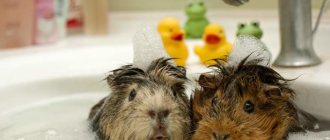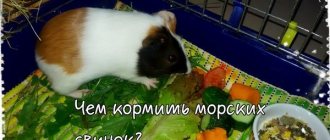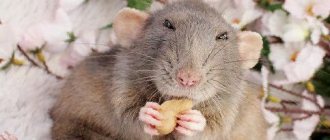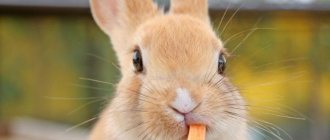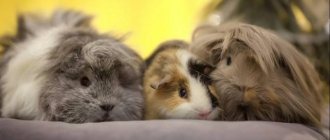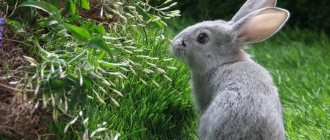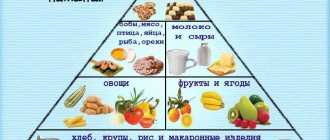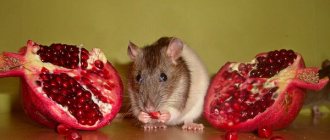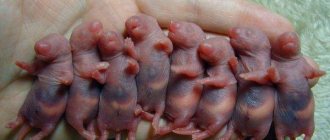Even experienced livestock breeders ask questions: what to feed their pet, whether it is possible to give certain products. Before getting a guinea pig, you should find out which foods will benefit the animal and which may harm its health. A guinea pig's daily menu should include vegetables, fruits, berries and cereals. Many vegetables and fruits can even be offered to your pet along with the peel. It is important to remember that not all foods that guinea pigs eat are equally beneficial for them. What rodents can eat and what they cannot feed a guinea pig is discussed in this article.
What to feed your guinea pig?
Guinea pigs are highly sensitive pets that require careful care, love and attention from their owner. In a starving rodent, after a day, the intestines stop working, and the animal dies.
Guinea pigs are highly sensitive pets that require careful care, love and attention from their owner. The digestive tract of rodents of this species is designed in such a way that for normal functioning and preservation of health, animals must receive the same food at home as they would receive in their natural habitat. The owner must clearly know what to feed the guinea pig. Adequate nutrition for an animal is a matter of vital importance. In a starving rodent, after a day, the intestines stop working, and the animal dies.
Feeding recommendations
The pet needs to be fed correctly so that its health remains normal, its teeth are strong, and its coat looks well-groomed. Your pet's daily menu should include:
- 50% hay;
- 20% dry food;
- 20% juicy food;
- 10% greens.
An important question for owners is how many times a day to give food to a guinea pig. Feeding is carried out 3 times a day. The feeder cannot be removed from the cage; food must always be available to the animal. There should also always be hay in the cage.
If there is no dry food in the animal’s diet, then it must be replaced with a similar weight of greens and raw vegetables. The menu should be varied; the rodent must be offered at least three different vegetables per day and certainly grass. It is prohibited to give your pet grass collected on the sides of highways and in industrial areas.
The optimal menu is vegetables and fruits before noon, dry food after noon.
Necessary for care
Like any other pet, a guinea pig requires a wide variety of grooming accessories. These include:
- cage or aquarium;
- feeder;
- sippy cup;
- house;
- filler;
- mineral stone;
- toys;
- carrying;
- hygiene products;
- brush-comb and nail clipper.
Cage or aquarium
Keeping a guinea pig is allowed both in an aquarium and in a cage. The main condition is size: the dwelling must be at least 50 cm in length and 30 cm in height so that the animal can move comfortably. If you have decided on a cage, then it is best to take a closer look at the options that have a plastic bottom. Plastic is quite easy to care for, it is easy to wash, dry, etc. A wooden base is not suitable due to the fact that these animals drink a lot of liquid per day, and therefore excrete a large amount of urine. The wood will simply become unusable in a very short time. You can purchase an aquarium in the above sizes. It, like a cage with a plastic bottom, is easy to wash and clean. But you should be careful, since glass is a very fragile material and when moving it, for example, to another room, you should follow safety rules (the pet should not be in the aquarium, it should be transferred to a carrier).
cell
Feeder
The feeder should be heavy enough so that the guinea pig cannot knock it over. An excellent option would be bowls made of ceramics, stainless steel, etc. It is also recommended to buy 2-3 containers. For example, one will be used for vegetables or fruits, and the second for dry food.
Sippy cup
A vertical ball sippy cup is perfect for a guinea pig. It is usually made of plastic with a metal tip. In such a drinking bowl there is no need to change the water daily, but this is done about 2-3 times a week.
House
Be sure to install a small house in the cage or aquarium. Your pet will sleep in it, relax, or simply retire when he wants to be alone. Most often, such houses are made of wood with a round “door” cut out in the middle. The most optimal size is 25 cm in length and 15 cm in height. This space is enough for the animal to hide and at the same time feel comfortable.
house
Filler
When arranging the cage, do not forget about the bedding. It will create comfort in the cage, prevent the animal from freezing and, to some extent, maintain cleanliness. You can use sawdust or ground corn cobs as a filler. Under no circumstances put cotton wool, newspaper, paper, etc. in the cage as bedding, as this is not safe for your pet’s health.
Mineral stone
To maintain dental health and calcium levels in your guinea pig's body, mineral stone is essential. After all, it serves not only as a vitamin complex, but also perfectly helps the animal grind its teeth. This stone is sold in a pet store, and its price is quite affordable.
stone
Toys
Guinea pigs are somewhat similar in behavior to decorative rabbits. They love to play. Therefore, be sure to buy some interesting and funny toy for your pet, for example, a tunnel, a hammock, a mirror, a rolling wheel, etc. The game will not only bring joy and pleasure to the animal, but will also strengthen muscles, and will also be an excellent preventive measure against obesity.
Carrying
If your plans did not include traveling together or any trips with your guinea pig, then you will still need a carrier. Transporting an animal in your arms, in a box or blanket is strictly prohibited. For example, you need to visit a veterinarian or transport the animal to another house or apartment; in such life situations, a carrier will definitely help you out. The pig will feel safe and the transportation process will go smoothly.
Hygiene products
Guinea pigs are considered clean animals, but sometimes they are still allowed to be bathed. For such cases, it is necessary to use special hygiene products that can be purchased at a pet store. The most popular of them:
- “Biogance” – bio-perfume;
- “Veda” – wheat shampoo.
Brush-comb and nail clipper
Caring for your guinea pig's coat and claws is extremely important. To do this, you need to purchase a special comb with soft bristles (combing is done daily), as well as a nail clipper for trimming the claws (the procedure is performed as they lengthen).
Grain feed
A guinea pig needs to eat at least 20% grain per day. Grain food for rodents is sold in any pet store. The finished product usually includes:
- barley;
- oats;
- millet;
- sunflower seeds;
- corn grains.
In addition to grain, prepared feeds may include vegetable granules and vitamin supplements.
Dry pet food is easy to prepare yourself; you just need to buy different types of grains on the market and then mix them. But you need to take into account that the main ingredient is oats; guinea pigs eat it more readily than other grains. Solid grain food should always be present in the diet of rodents. Animals need it to grind down their continuously growing teeth. If a rodent eats only raw and soft food, then its incisors become unnaturally elongated and interfere with the ability to absorb food. As a result, the animal dies from starvation.
Green feed
This food for guinea pigs is the most healthy and natural. Your pet should eat fresh greens, rich in fiber and nutrients, to maintain normal functioning of the intestinal tract. Below is a list of herbs recommended for guinea pigs:
- cereal sprouts;
- spinach;
- lettuce leaves;
- clover;
- carrot tops;
- beet tops;
- dill, parsley, cilantro;
- plantain;
- yarrow;
- chamomile;
- dandelion leaves.
You need to be very careful when collecting grass for your pet. Among the useful plants there may be poisonous ones. Therefore, you should not put a bunch of grass in a cage without carefully sorting it out first. Fresh greens for your guinea pig should be thoroughly washed.
Pet diet at home
The diet of guinea pigs should be varied, but without daily experiments, which can cause problems in the animal’s digestive system. Standard set of products:
- carrots (pumpkin, zucchini, beets),
- apple (hard pears, raspberries, apricots, peach);
- white or cauliflower;
- high-quality granulated food;
- greens (parsley, dill, clover, dandelion leaves, wood lice grass);
- unlimited quantities of hay.
In the summer season, carrot and beet tops, cucumbers from your garden and fresh grass are good complementary foods.
Vegetables
Vegetables that you can offer your pig and choose the types that she tolerates well:
- carrot;
- beet;
- zucchini;
- pumpkin;
- cauliflower;
- White cabbage;
- Bulgarian pepper;
- swede;
- turnip;
- green pea pods;
- cucumbers;
- tomatoes.
Hay
The most important food for guinea pigs. Hay not only normalizes the functioning of the intestinal tract, but is also an excellent tool for grinding down the incisors of rodents. Like grain, hay is sold at any pet store. When purchasing, it is important to carefully check that the dried grass is not affected by mold. Rotten and moldy hay can harm your pet's body. If the owner is engaged in the preparation of hay on his own, then he must carefully inspect the collected grass for the presence of prickly, weeds, and poisonous plants.
Berries and fruits
Natural berries and fruits contain the bulk of the vitamins your guinea pig needs, not just the treats your guinea pig loves. Fruits are not forbidden to the animal; they can be included in the daily diet, the animal will choose what it likes more, and advice from a veterinarian on nutrition is also possible. Veterinarians do not recommend giving your guinea pig a lot of sweet fruits. They are more likely to have indigestion, which occurs more often in them than in other rodents. A large number of sweet tangerines, apples and pears can cause just such a disorder. Give tangerines to your pet with particular care. They are, of course, an essential source of vitamin C, which the pig's body does not produce, and citrus fruits are the main source. But tangerines are strong allergens. You can give a little, a slice every day and watch the behavior of the guinea pig to see if it has developed an allergy.
Juicy plant products
The category of such food products includes vegetables and fruits. The diet should include mainly vegetables; fruit pulp is just a treat for guinea pigs. You should not give your pet too much fruit. Their pulp is saturated with sugars, which in excess are harmful to the body of a small animal. From time to time, the guinea pig is allowed to treat a small amount of cherries, apples, peaches, nectarines, apricots, pears, bananas.
The rodent enjoys eating vegetables and berries:
- carrots;
- white and cauliflower;
- zucchini;
- tomatoes;
- bell pepper;
- cucumber;
- corn;
- pumpkin;
- celery;
- seedless grapes;
- green peas.
It is useful to treat the animal once a week with berries rich in ascorbic acid: strawberries, currants, raspberries, wild strawberries. You can also periodically offer the animal leaves and twigs of cherries, blueberries, raspberries, gooseberries, and mint.
Eggplants and green tomatoes should not be included in the diet; these vegetables contain solanine, a toxic compound also present in green potatoes. It is strictly forbidden to give your pet leeks, onions and green onions. Bulb crops are poisonous to rodents.
Many owners are interested in whether it is possible to treat a guinea pig with melon and watermelon. The animal willingly feasts on such a treat and even eats watermelon rinds with pleasure. But you need to keep in mind that melon and watermelon are very sweet products, so you shouldn’t include them often in your diet.
You can diversify your pet's menu with fresh peas, soybeans, lentils, and green beans. It is useful to give your rodent juicy pea pods, rich in vitamins and nutrients.
Vegetables
Can guinea pigs have radishes?
It is permissible to use only radish tops. The root vegetable contains essential oils that can cause irritation to the mucous membranes and respiratory tract of the animal. The vegetable also causes bloating. Therefore, it is not recommended to give radishes to pigs.
Can guinea pigs eat celery?
Celery can be given in any form - stems, leaves, roots. This vegetable is included in many dry food for rodents. Celery is enriched with vitamins B, PP, E, C, A and contains phosphorus, zinc, potassium, calcium, iron and magnesium. Before eating, celery must be washed thoroughly, especially the root.
Can guinea pigs eat tomatoes?
Ripe fruits can be included in the food. Tomatoes are well absorbed by animals and contain vitamin C and carotene, which are beneficial for their body. Green tomatoes contain solanine, which can negatively affect your pet’s health.
Too many tomatoes in an animal's menu can cause loose stools.
Can guinea pigs eat cabbage?
Cabbage can be included in the animal's diet. Cabbage contains many vitamins and other substances necessary for pigs:
- ascorbic acid;
- B vitamins;
- vitamins of the PP group;
- folic acid;
- sulfur;
- calcium;
- potassium;
- phosphorus;
- amino acids;
- microelements.
Today we have cabbage lunch.
The vegetable is able to keep the animal’s fur in excellent condition and strengthen its immunity. The top dried leaves should be given. It is preferable to feed guinea pigs Chinese cabbage and broccoli. White cabbage can cause bloating.
Can guinea pigs eat potatoes?
Green and sprouted potatoes are contraindicated for guinea pigs. Raw vegetables can be given occasionally, cut into small pieces. Boiled potatoes can be offered to your pet separately or added to grains and other foods.
The vegetable contains solanine, which can harm the health of the animal if the pet eats too many potatoes. The pig will become passive and catch cold quickly.
Can guinea pigs eat beets?
Beetroot contains many substances useful for animals: vitamins C, A and B, potassium, magnesium, phosphorus, iron. In excess, the vegetable contains fiber, so it acts on the animal’s body as a laxative. Store-bought root vegetables may contain nitrates, which are very harmful to the small body of guinea pigs. It is better to offer your pet homemade crops. The composition also contains a large amount of oxalic acid, so it is better to limit the consumption of this product.
It is recommended to give beets starting from 2 months; they are especially useful in winter and spring, when there are no fresh vegetables. The daily dose should not exceed 200 g, and it is better to exclude beets from the diet of pregnant and lactating pigs so as not to provoke an upset stomach. Beets turn stool and urine red, so if your animal has eaten them, don’t be alarmed by such changes.
Can guinea pigs eat pumpkin?
Pigs can be given all varieties of pumpkin that humans eat. For the digestion of herbivorous animals, such a product will be familiar and useful. Pumpkin contains vitamin C, calcium and phosphorus necessary for rodents. It should be borne in mind that this low-calorie vegetable will not be able to saturate the pig completely, so it is better to give pumpkin to guinea pigs as a treat.
Can guinea pigs eat bell pepper?
Another storehouse of ascorbic acid is bell pepper. Before use, the vegetable must be thoroughly washed and chopped, and the seeds removed. It is better to give the product together with dry food.
Green peppers containing solanine should not be given to animals, as should peppers in the form of hot seasonings. Spicy foods will damage the mucous membranes.
Can guinea pigs eat cucumber?
Cucumbers don't have as many nutrients as other vegetables. You can offer your pet a cucumber. The vegetable can harm your pet's health by causing digestive problems only if consumed in large quantities.
Can guinea pigs eat zucchini?
Zucchini is suitable for the diet of guinea pigs. They contain small amounts of vitamin C, calcium and phosphorus. It is better to prefer young vegetables; they can be given along with the peel, cut into crowbars.
Additional sources of vitamins and minerals
Most of all, a guinea pig needs vitamin C. Ascorbic acid is not synthesized at all in the body of rodents of this species. Therefore, animals must daily absorb a significant amount of food saturated with vitamin C. Phylloquinone and B vitamins can be absorbed in the guinea pig’s body only after repeated consumption, that is, after the animal eats its own feces. Therefore, a rodent that eats droppings cannot be stopped.
Of the minerals, salts and calcium are especially important for guinea pigs. Therefore, it is recommended to buy mineral sticks for your pet at the pet store. It is also permissible to treat your rodent with fish oil and bone meal as useful supplements.
Water
There must be a drinking bowl with fresh water in your pet's cage. An adult animal needs 250 ml of fluid per day, but a pregnant female needs a little more. It is recommended to buy a drinking bowl for your pet. In such a device, the water will not become dirty or spill.
It is advisable to give the rodent bottled or filtered water rather than boiled water. The owner must carefully ensure that dirt and debris do not get into the drinking bowl. By consuming contaminated water, your guinea pig can contract an infection.
Tree branches
Twigs, leaves and any other parts of the following trees are contraindicated for guinea pigs: cypress, yew, holly, thuja, robinia, buckthorn.
The pet is also not allowed to eat acorns, nuts and chestnuts, but is allowed to try the branches of these trees from time to time. In small quantities they will not cause harm.
What drinks can you give your guinea pig?
Just remember that it is safe for pigs to drink only plain, clean water. Bitter, sweet, carbonated and alcoholic drinks are prohibited. At best, they will cause severe stomach upset, and at worst, the death of the pet.
Foods harmful to guinea pigs
The following is a list of foods that can cause serious harm to a rodent's body:
- white and black bread, pasta;
- meat and dairy products;
- potato;
- mushrooms;
- baked goods, sweets;
- cereals, dry legumes;
- fruit and berry seeds;
- radish, radish;
- sorrel, rhubarb;
- juice, tea, jelly and other drinks other than water;
- leaves of indoor plants that are poisonous to rodents;
- canned food, spices, cheese and other delicacies;
- waste from the human table.
Guinea pigs love to chew on young tree branches. You should not give your pet oak, willow, pine, spruce, rowan, hornbeam, or elm branches. But you can safely put cherry, hazel, plum, apple, and pear branches in the feeder.
Indoor flowers
During walks outside the cage, the animals sometimes gnaw on some indoor plants. This must be stopped immediately because most domestic plants are poisonous to pigs. It is better if the pots are located in places inaccessible to rodents.
The most popular indoor plants that are dangerous for pigs:
- azalea;
- ficus;
- lilac;
- jasmine;
- chrysanthemum;
- dahlias;
- geranium;
- lily;
- Dracaena broom.
Palm trees and cacti should also be kept away from a curious pet.
Nutrition for pregnant pigs and newborn piglets
Pregnant pets must eat well and of high quality. The diet of furry mothers should be rich in proteins and vitamins. It is useful to give pregnant females carrots, beets, and wheat sprouts. You can periodically add a little milk to the water. Rosehip infusion brings great benefits to the body of a pregnant pig.
If the female who gave birth does not have milk, then the owner will have to feed the cubs on his own using a syringe. Artificial food for small piglets includes low-fat cream and the probiotic Linex. The cream is taken into the syringe and a tenth of the probiotic capsule is added to it. The resulting solution is nutritious and beneficial for the digestive system of babies. The food in the syringe is warmed to room temperature. Piglets take 1 ml of food every hour. Two-week-old babies can be switched to cereal porridge without milk. The piglets sit on the porridge until they get used to “adult” food.
animalsprotectionpetcare
